The Scottish Health Survey 2021 - volume 1: main report
Presents results for the Scottish Health Survey 2021, providing information on the health and factors relating to health of people living in Scotland.
Chapter 6 Physical Activity
Chapter Summary
In 2021, significantly more adults met the guidelines for moderate or vigorous physical activity (MVPA)1, than previous years, continuing a general upwards trend since 2012.
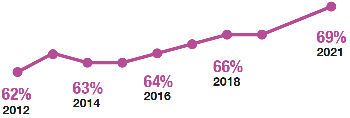
In 2021, a higher proportion of men met the MVPA guidelines than women.
- 73% men
- 65% women
Adults aged between 16 and 54 were more likely than older adults to have met the MVPA guidelines in 2021.
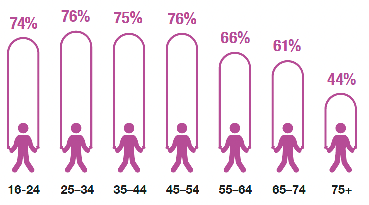
In 2021, the proportion of adults who met the MVPA guidelines was lowest among those living in the most deprived areas.
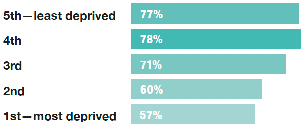
In 2021, just over a third of adults adhered to both the MVPA and muscle strengthening guidelines2. As age increased the proportion of adults adhering to both guidelines decreased.
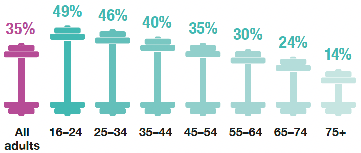
In 2021, the majority of children aged 5-15 met the recommended guideline of at least 60 minutes of activity on average per day in the previous week. Boys were more likely than girls to meet the physical activity guidelines.
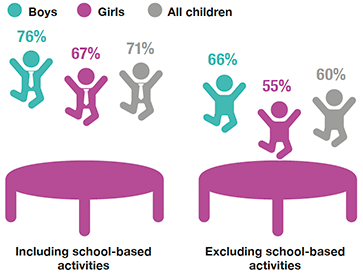
Across all age groups a higher proportion of boys adhered to the physical activity guidelines, with the highest proportion of children meeting the physical activity guidelines among those aged 5-7.
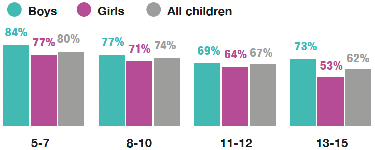
1 At least 150 minutes of moderately intensive physical activity or 75 minutes vigorous activity per week or an equivalent combination of both.
2 Carries out activities that strengthen muscles on at least two days per week.
Physical Activity
Alys Daniels-Creasey
6.1 Introduction
The World Health Organisation lists physical inactivity as one of the four key modifiable behaviours which increase the risk of non-communicable diseases (NCDs), along with tobacco use, unhealthy diet, and the harmful use of alcohol. A lack of physical activity can lead to raised blood pressure and obesity, as well as increased concentrations of glucose and fats in the blood. These, in turn, may contribute to cardiovascular disease, the primary non-communicable cause of premature deaths.[1]
The UK Chief Medical Officers' Physical Activity Guidelines[2] (2019) were constructed as advice to the general population about the recommended frequency, intensity, time and types of physical activity required to prevent major chronic disease and to maintain health.
The guidelines recommend that, for good physical and mental health, adults should aim to be physically active every day. Any activity is better than none, and more is better still. Each week, adults should accumulate at least 150 minutes of moderate intensity activity; or 75 minutes of vigorous intensity activity; or even shorter durations of very vigorous intensity activity; or a combination of moderate, vigorous and very vigorous intensity activity. The guidelines also recommend that muscle strengthening activities are undertaken on at least two days a week but that any strengthening activity is better than none. Sedentary time should be minimised as far as possible.
6.1.1 Policy Background
The Active Scotland Outcomes Framework[3] sets out the shared vision and goals which have shaped the approach the Scottish Government and a wide range of partner organisations have taken to supporting and enabling people in Scotland to be more physically active. The framework facilitates a cross-government commitment to the importance of physical activity and sport in achieving a wide range of outcomes.
The Active Scotland Delivery Plan, published in 2018, identifies a wide range of actions across all sectors with the overall aim of reducing physical inactivity in adults and teenagers by 15% by 2030 and addressing existing inequalities in access to opportunities for and barriers to participation in physical activity.[4]
6.1.2 Reporting physical activity in the Scottish Health Survey (SHeS)
This chapter presents findings on summary activity levels[5] for adults and children and muscle strengthening activity among adults.
Breakdown of adult physical activity by deprivation is presented in Scottish Index of Multiple Deprivation (SIMD) quintiles. To ensure that the comparisons presented are not confounded by the different age profiles of the quintiles, the data have been age-standardised. For a detailed description of both SIMD and age-standardisation as well as definitions of other terminology used in this chapter and for details on the 2019 UK Physical Activity Guidelines and data collection methods for physical activity, please refer to Chapter 2 the Scottish Health Survey 2021- volume 2: technical report.
Supplementary tables on physical activity are also published on the Scottish Government website: Scottish Health Survey.
6.2 Physical Activity
6.2.1 Adult summary activity levels, 2012 to 2021, by sex
In 2021, 69% of adults met the guidelines for moderate or vigorous physical activity (MVPA) of at least 150 minutes of moderate physical activity or 75 minutes of vigorous physical activity, or an equivalent combination of the two per week. This is significantly higher than the proportions recorded between 2012 and 2019, which were in the range 62% to 66%.
Smaller proportions of all adults in 2021 reported undertaking some (10%), low levels (4%) or very low levels (16%) of physical activity.
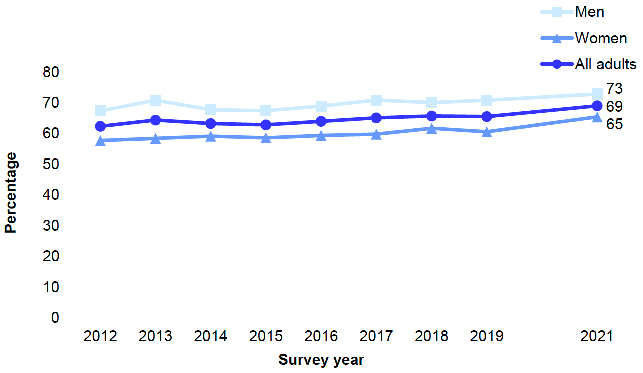
As in previous years, a higher proportion of men (73%) reported adhering to the guidelines than women (65%). However, between 2019 and 2021, there was a significant four-percentage-point increase for women (from 61% to 65%), while the two-percentage-point increase for men (from 71% to 73%) was not significant. Figure 6A, Table 6.1
6.2.2 Adult summary activity levels, 2021, by age and sex
As reported in 2019, younger adults were more likely than older adults to have met the MVPA guidelines in 2021 (74% to 76% among those aged 16-54, compared with 66% among those aged 55-64, 61% among those aged 65-74 and 44% among those aged 75 and over).
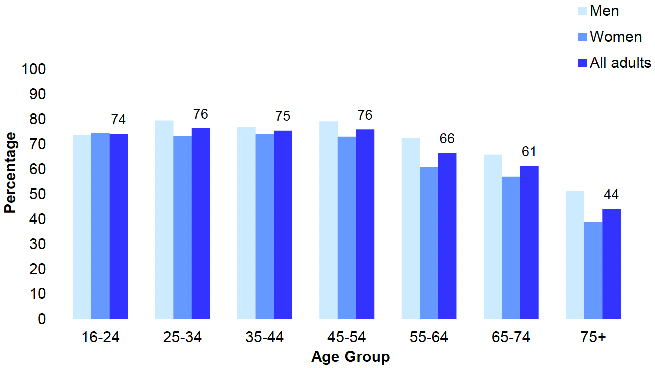
In 2021, significant differences in MVPA guideline adherence were recorded by sex among older groups, with 72% of men aged 55-64 having met these guidelines compared with 61% of women, as did 66% of men compared with 57% of women among those aged 65-74 and 51% of men compared with 39% of women among those aged 75 and older. Figure 6B, Table 6.2
6.2.3 Adult summary activity levels (age-standardised), 2012 to 2021, by area deprivation and sex
The extent of inequalities in age-standardised MVPA guideline adherence has varied since 2012, however, adherence has continued to be highest among those in the least deprived quintiles and lowest among those living in the most deprived quintiles. In 2021, the age-standardised proportion of adults who met the MVPA guidelines was lowest among those living in the most deprived quintile (57%) and highest among those living in the two least deprived quintiles (77% - 78%).
Similar patterns were evident among men and women.
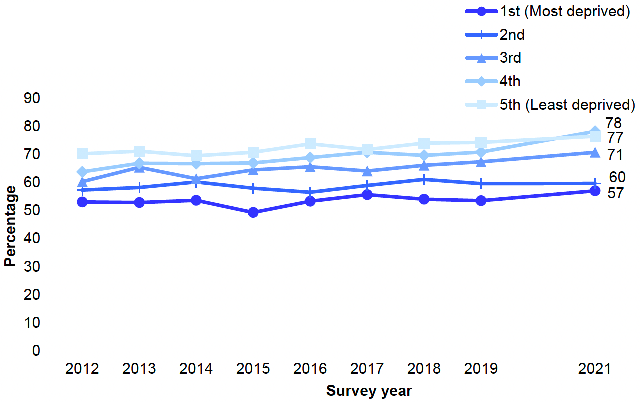
Figure 6C, Table 6.3
6.2.4 Adult muscle strengthening physical activity, 2021, by age and sex
In 2021, 35% of adults adhered to both the MVPA guidelines and muscle strengthening recommendations,[6] whereas 34% met the MVPA guideline only. Three in ten adults in 2021 (30%) did not meet either of these, while 1% fulfilled the muscle strengthening recommendation only.
While a similar pattern was reported in 2019, a significant increase in the proportion of adults who met both the MVPA and muscle strengthening recommendations was recorded in 2021, with an increase from 29% to 35% among all adults.
Men were more likely than women to meet both guidelines in 2021 (38% and 32% respectively), while similar proportions met the MVPA guidelines only (35% and 33% respectively).
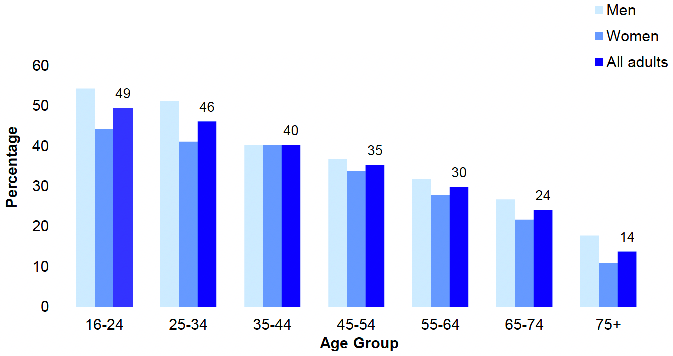
In 2021, as age increased, the proportion of participants who adhered to both the MVPA and muscle strengthening recommendations decreased, from 49% among those aged 16-24 to 14% among those aged 75 and over. Similar patterns were recorded among men and women.
In 2021, around a quarter of those aged 16-54 (22% - 25%) did not meet either the MVPA guidelines or muscle strengthening recommendations, a proportion which increased to 32% of those aged 55-64, 37% of those aged 65-74, and 54% of those aged 75 and over. Within these older age groups, there were also greater variations by sex than among the younger age groups, with a significant difference found between men aged 55-64 (27%) compared with women aged 55-64 (37%), and between men and women aged 75 and over (47% and 58% respectively). Figure 6D, Table 6.4
6.2.5 Children summary activity levels (including and excluding school-based activities), 1998 to 2021, by sex
In 2021, the majority of children aged 5-15 did at least 60 minutes of activity on average per day in the previous week: 71% when including school-based activities and 60% when excluding school-based activities. Neither result was significantly higher than the equivalent figures in 2019, which were 70% and 59% respectively.
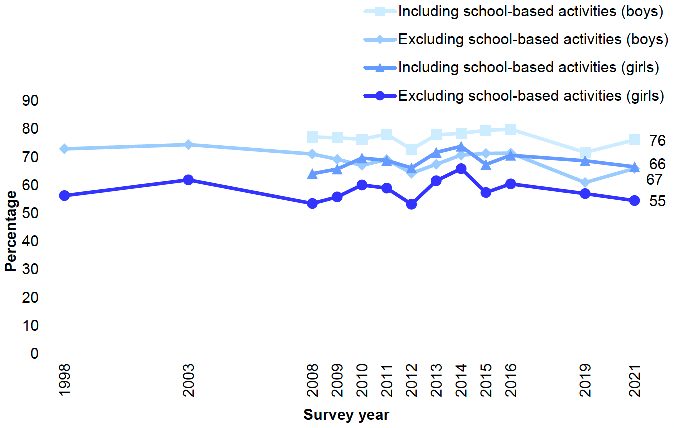
In line with previous years, boys were more likely than girls (aged 5-15) to meet the recommended level of physical activity on average per day in the previous week with significantly higher proportions in 2021 doing so both including school-based activities (76% of boys compared with 67% of girls) and excluding school-based activities (66% and 55% respectively). Despite apparent increases among boys both including and excluding school-based activity since 2019, the differences were not significant for either boys or girls. Figure 6E, Table 6.5
6.2.6 Children summary activity levels, including school-based activities, 2021, by age and sex
In 2021, in addition to the 71% of all children aged 5-15 who met the physical activity guidelines of at least 60 minutes on average per day in the previous week, 18% achieved 30-59 minutes a day on average across the previous week, and 10% reported less than 30 minutes of physical activity on average per day.
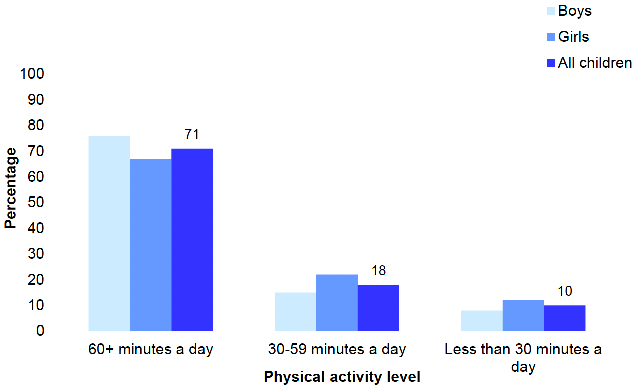
In 2021, while girls were more likely to undertake 30-59 minutes of activity on average per day (22%) than boys (15%), there was no significant difference in the proportions of children undertaking less than 30 minutes of physical activity on average per day by sex (8% among boys and 12% among girls).
Adherence to physical activity guidelines for children varied by age in 2021, decreasing from 80% of those aged 5-7, the highest proportion of any of the children's age groups, to 62% among those aged 13-15.
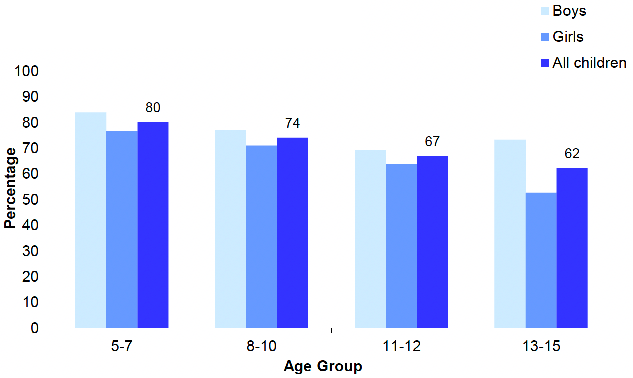
Across all age groups, a higher proportion of boys than girls adhered to the physical activity guidelines in 2021. This variation was only significant among those aged 13-15, with a 20-percentage-point difference between boys and girls (73% and 53% respectively). Figures 6F and 6G, Table 6.6
Table list
Table 6.1 Adult summary activity levels, 2012 to 2021, by sex
Table 6.2 Adult summary activity levels, 2021, by age and sex
Table 6.3 Adult summary activity levels (age-standardised), 2012 to 2021, by area deprivation and sex
Table 6.4 Adult muscle strengthening physical activity, 2021, by age and sex
Table 6.5 Children summary activity levels (including and excluding school-based activities), 1998 to 2021, by sex
Table 6.6 Children summary activity levels (including school-based activities), 2021, by age and sex
The tables can be found on the main report page under supporting files.
References and notes
1. World Health Organization (2021). Noncommunicable diseases.
2. UK Chief Medical Officers' Physical Activity Guidelines (2019).
3. Active Scotland Outcomes Framework (shinyapps.io).
4. See Active Scotland Delivery Plan.
5. While the guidelines differ for those aged 16 to 18 years old, for the purposes of SHeS, the activity of these participants is included in the all adult calculations.
6. Carrying out at least ten minutes of exercise causing the muscles to feel some tension, shake or feel warm on at least two days of the week.
Contact
There is a problem
Thanks for your feedback